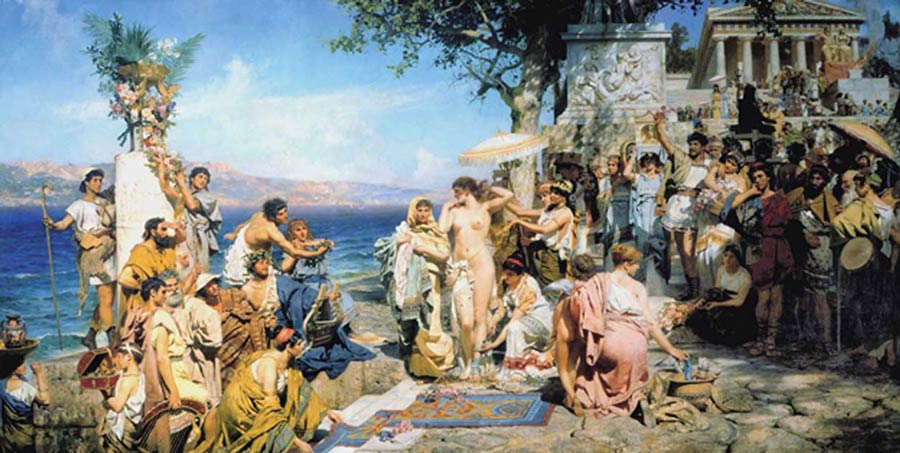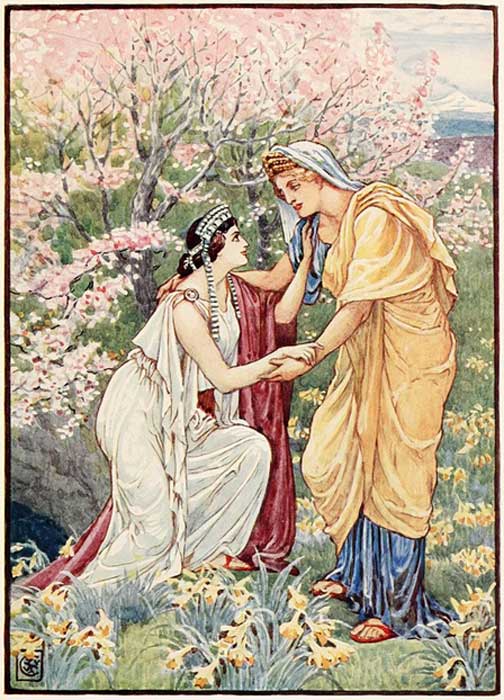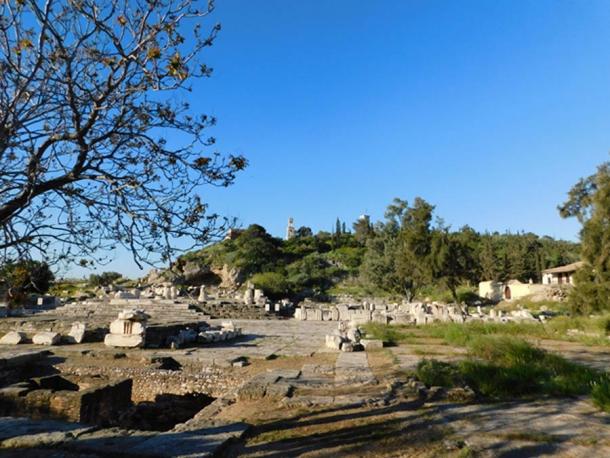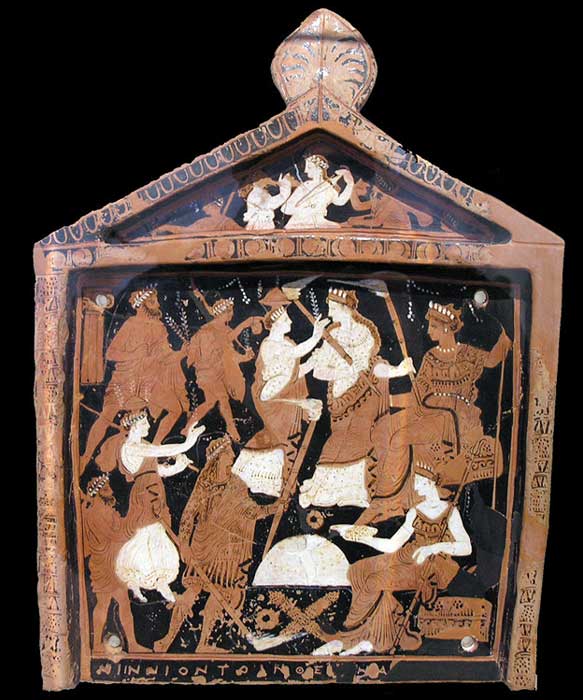To this day the Eleusinian mysteries remains a subject enveloped by broken pieces of information, creating great controversy among historians who work under heavy assumptions while trying to piece together this ancient tradition. Complete details involving the rites and celebrations which took place during the mysteries were marked by a sworn oath of secrecy by the initiated and, therefore, vanished from our knowledge. In that respect, what do we know about the mysteries and what is just speculation? Although modern historians still argue about different aspects regarding the mystic rituals, some ideas are often accepted among them, which are understood by the testimonials of the initiated.
In ancient Greece, the town of Eleusis, situated west of Athens, became the most important religious center of the pagan world during its time. According to the old belief and narrations in Homeric Hymn, Demeter (goddess of agriculture) stopped to rest at Eleusis during her quest for her daughter, Persephone, who was kidnapped by Hades. There, Demeter ordered a temple and altar to be built in her honor. After the joyful reunion of the goddess with the missing Persephone, she instructed the leaders of Eleusis in how to perform her rites. The cult, then, is believed to have been taught directly by Demeter herself.
Parts of the Rite
It is known that different levels of initiation took place in the cult, and that three categories of events existed: the dromena (things which were enacted), the deiknumena (things which were shown), the logomena (things which were explained). The Eleusinian mysteries was broken down into two parts, happening at different times of the year: the 'Lesser mysteries', a preliminary initiation involving purification which would have taken place in the spring at Agrae (a suburb of Athens), and the 'Greater mysteries' in Eleusis, which would have taken place during the Autumn, in late September, for those who had been purified in the previous rite. The participants would have spent a number of days in Athens preparing for this second part of the cult. I must point out that the duration and frequency of these events remains a subject of debate among historians.
A central part of the rite involved the drinking of a sacramental barley and mint beverage called 'kykeon'. It is suggested that the 'kykeon' might have been infused with the fungus ergot and possibly mixed with other hallucinogeni c which would, then, produce a strong psychedelic experience, helping with the transformation of the initiates. After drinking the 'kykeon', the initiates entered the Telesterion, which resembled an underground theater, where the secret part of the ritual took place. Historians believe that this part of the rite was a symbolic re-enactment of the death and rebirth of Persephone.
Meaning Behind the Eleusinian Mysteries
The festivities are believed to revolve around the symbolic representation of Demeter's search for Persephone. A well accepted theory is that Demeter and Persephone symbolize life, death, and even immortality; that they gave the initiate confidence to face death and a promise of bliss in the dark domain of Hades. Whatever happened in the Telesterion, those who entered in would come out the next morning radically changed.
- New Study Shows Some Greek Temples Were Oriented to the Moon or Stars, Rather than the Sun
- A marble slab inscription invoking a goddess sheds light on Thracian history
According to studies done by George Mylonas, the growing popularity of this cult led to the expansion of the original temple of Demeter in Eleusis. In those days of antiquity, Mylonas states, "people from all over the civilized world, men, women, and children- free men or women unstained by crime- even slaves, aspired to be initiated into its mysteries and annually flocked to the sanctuary of Eleusis. Not only simple peasants but even the leaders of thought and politics were anxious to take part in the rites". But in order to participate in the Greater mysteries the initiates were required to have gone through the preliminary part of the ritual, as it was prescribed by Demeter.
A famous fragment of a text by Aristotle commenting on initiates to the mysteries reports that those individuals become worthy not so much because they learn something new ( 'mathein') but because they suffer or experience ( 'pathein') something appropriate to the proceeding, as Nancy A. Evans explained. The main determining factor for the participation in this powerful experience was access to resources, as it was open to all people who were free of crimes. Each initiate needed to purchase piglets and needed to pay 15 drachmae to the priest to cover the costs of the great civic sacrifices on the first and last days of the festival. Gender, age, ethnicity, and civic status-citizen, metic or slave- played a different role at Eleusis than in virtually every other type of Pan-Hellenic cult experience.
A Distinguished Initiate of the Eleusinian Mysteries
Plato, who was an initiate of the mysteries, mentioned it in his dialogue on the immortality of the soul, the 'Phaedo', saying that "our mysteries had a very real meaning: he that has been purified and initiated shall dwell with the gods". Joshua J. Mark points out that Plutarch, also an initiate, wrote that "because of those sacred and faithful promises given in the mysteries...we hold it firmly for an undoubted truth that our soul is incorruptible and immortal", and he continued further, "when a man dies he is like those who are initiated into the mysteries. Our whole life is a journey by tortuous ways without outlet. At the moment of quitting it come terrors, shuddering fear, amazement. Then a light that moves to meet you, pure meadows that receive you, songs and dances and holy apparitions".
Cicero praised the mysteries, writing "nothing is higher than these mysteries...they have not only shown us how to live joyfully but they have taught us how to die with a better hope". In Waverly Fitzgerald’s words, “it was said of those who were initiated at Eleusis that they no longer feared death and it seems that this myth confirms the cyclical view of life central to pagan spirituality: that death is part of the cycle of life and is always followed by rebirth."
- The Sacred Sex and Death Rites of the Ancient Mystery Groves
- Mushroom Monuments of Thrace and Ancient Sacred Rites
The End of the Mysteries
During the fifth and fourth centuries BC, the Eleusinian mysteries quickly assumed the status of the most important and widely attended mystery cult in the Greek-speaking world, a position kept throughout antiquity until the emperor Theodosius issued edicts against mystery cults in the late fourth century AD. Historians do know that those who participated in the mysteries were forever changed for the better and that they no longer feared death. The initiates returned from their pilgrimage to Eleusis full of joy and happiness and filled with hope of a better life in the world of shadows, but, as Mylonas states, "the ancient world has kept its secret well, and the mysteries of Eleusis remain unrevealed".
https://www.ancient-origins.net/history/eleusinian-mysteries-006903
You need to be a member of Ashtar Command - Spiritual Community to add comments!









Replies